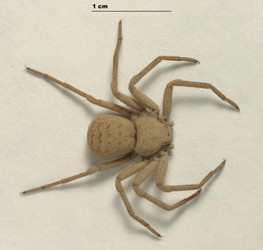Sicariidae
Greta Binford


This tree diagram shows the relationships between several groups of organisms.
The root of the current tree connects the organisms featured in this tree to their containing group and the rest of the Tree of Life. The basal branching point in the tree represents the ancestor of the other groups in the tree. This ancestor diversified over time into several descendent subgroups, which are represented as internal nodes and terminal taxa to the right.

You can click on the root to travel down the Tree of Life all the way to the root of all Life, and you can click on the names of descendent subgroups to travel up the Tree of Life all the way to individual species.
For more information on ToL tree formatting, please see Interpreting the Tree or Classification. To learn more about phylogenetic trees, please visit our Phylogenetic Biology pages.
close boxCharacteristics
Note the violin shaped mark on the cephalothorax (front half of body) and the six eyes, grouped in pairs.References
Binford, G.J., Callahan, M.S., Bodner, M.R., Rynerson, M.R., Berea Núñez, P., Ellison, C.E., Duncan, R.P. 2008. Phylogenetic relationships of Loxosceles and Sicarius spiders are consistent with Western Gondwanan vicariance. Molecular Phylogenetics and Evolution 49:538-553.
Platnick, N. I., J. A. Coddington, R. R. Forster, and C. E. Griswold. 1991. Spinneret Morphology and the Phylogeny of Haplogyne Spiders (Araneae, Araneomorphae). American Museum Novitates 3016: 1-73.
Title Illustrations

| Scientific Name | Sicarius terrosus |
|---|---|
| Location | Parque Sierra de las Quijadas, Argentina |
| Creator | Dr. Kenneth Cramer |
| Specimen Condition | Live Specimen |
| Image Use |
 This media file is licensed under the Creative Commons Attribution-NonCommercial License - Version 3.0. This media file is licensed under the Creative Commons Attribution-NonCommercial License - Version 3.0.
|
| Copyright | © 2005 Dr. Ken Cramer |
| Scientific Name | Loxosceles laeta |
|---|---|
| Location | ex Instituto Butanan, Sao Paulo, Brazil |
| Specimen Condition | Live Specimen |
| Identified By | Jonathan Coddington |
| Sex | Female |
| Life Cycle Stage | adult |
| Image Use |
 This media file is licensed under the Creative Commons Attribution-NonCommercial License - Version 3.0. This media file is licensed under the Creative Commons Attribution-NonCommercial License - Version 3.0.
|
| Copyright |
© Jonathan Coddington

|
About This Page
Greta Binford

Lewis & Clark College, Portland, Oregon, USA
Correspondence regarding this page should be directed to Greta Binford at
Page copyright © 2009 Greta Binford
All Rights Reserved.
- First online 07 December 2006
- Content changed 18 February 2009
Citing this page:
Binford, Greta. 2009. Sicariidae. Version 18 February 2009 (under construction). http://tolweb.org/Sicariidae/2731/2009.02.18 in The Tree of Life Web Project, http://tolweb.org/









 Go to quick links
Go to quick search
Go to navigation for this section of the ToL site
Go to detailed links for the ToL site
Go to quick links
Go to quick search
Go to navigation for this section of the ToL site
Go to detailed links for the ToL site